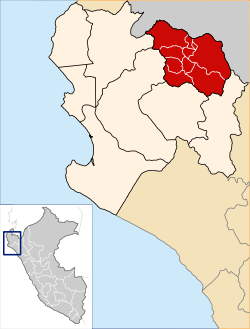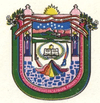Ayabaca Province
| Ayavaca o Ayabaca | |||
|---|---|---|---|
| Province | |||
| |||
 Location of Ayavaca o Ayabaca in the Piura Region | |||
| Country | Peru | ||
| Region | Piura | ||
| Founded | January 14, 1865 | ||
| Capital | Ayavaca or Ayabaca | ||
| Government | |||
| • Mayor | Humberto Marchena Villegas | ||
| Area | |||
| • Total | 5,230.68 km2 (2,019.58 sq mi) | ||
| Elevation | 2,709 m (8,888 ft) | ||
| Population | |||
| • Total | 38,245 | ||
| • Density | 7.3/km2 (19/sq mi) | ||
| UBIGEO | 2002 | ||
| Website |
www | ||
Ayabaca or Ayavaca is one of the eight provinces of the Piura Region, in northwestern Peru. It borders Ecuador on the north and northeast, Huancabamba Province and Morropón Province on the south, and the Piura and Sullana provinces on the west. This province is located in the western Andes and its capital is the town of Ayabaca, which is the highest in the whole region.
Two bus companies cover the route Piura-Sullana-Ayavaca. The trip takes from 5 to 6 hours approximately. The province has a large border with Ecuador, and the oriental branch of the Pan-American Highway crosses the Suyo district, at the north of the province, connecting Piura, Sullana and Las Lomas with the Ecuadorian cities of Macará and Loja.
Etymology
The name Ayabaca, also written as Ayavaca, derives from two Quechua roots: aya, related to death, but also to immortality; and huaca connected to sanctuaries and sacred places. Some local monographs have limited its meaning to that of "grave and ancient tomb of the dead" ("tumba de muertos"), considering possible links between this designation and the findings of bones and primitive weapons near the zone where the Spaniards gathered the native population in 1571, when they founded the first "Pueblo de Indios de Nuestra Señora del Pilar de Ayavaca" or "Ayavaca Vieja". Under this supposition, such bones and weapons would be the "remains of hordes fallen in combat against the expansionist advance of the Incas". For a better understanding of the etymology of aya huaca or aya waka, it must be considered that aya does not only mean deceased or ancestor in the physical sense of the corpse or skeleton, but also in the symbolic and spiritual sense of the soul, consciousness and energy that departs the body, temporarily at night and definitely at the end of the life, but continues circulating in all vital processes, as the cycles of water, light and seasons, that move along with the Earth; for that reason, aya is also related to the pale red or yellowish colors of twilight and of dawn, as well as to the paleness of newborns and dying persons, while huaca is the name of sacred places or objects. In this sense, the old sanctuary of Ayavaca or Ayahuaca, situated in the western extreme of the mountain range of the Andes, an area where all regional rivers have their sources, is properly the Sanctuary of Death, but also of Immortality, of life’s changes and transformation. http://es.scribd.com/doc/79485308/AYAVACA-CON-V-DE-VERDAD
Tourist attractions
One of Ayavaca's most important attractions is the Aypate Inca construction, at 49 kilometers (30 mi) east of the province's capital, located on, or in front of an ancient pre Inca sanctuary. In 1996, the regional office of the National Institute of Culture gave to Aypate the recognition of "Archaeological Capital of Piura". The name of Aypate (Also Aypache or Allpachí), also identifies an important legendary figure considered a founding father in the history of this region. The legend describes the beginning of a golden age after a human triumph in understanding and conquering nature without harming it.
Other interesting testimonies of the old local culture exist in different places of the province, under the form of petroglyphs (El Toldo, Samanga), megalithic altars (Chocán, Montero), and remainders of the old Qhapaq Ñan or Inca road.
Ayavaca has also a multiplicity of landscapes that encompass zones of dry forest and areas of almost permanent humidity located in the mountain range, a region of páramos, lakes and humid forests that conform the main freshwater sources of all the Piura region. Some of these lakes are the Laguna Prieta, near Huamba and Samanga, the Lagunas Arrebiatadas, an assembly of lakes connected in descending levels, the Laguna del Cristal, El Cántaro and the lake of Santa Clara or Siete Poderes.
Likewise, in the large mountain area shared by the provinces of Ayavaca and Huancabamba, there is a great assembly of well known lakes locally known as The Huarinjas or Huaringas, one of them is the very important Laguna del Rey, (Lake of the King or Lake of the Inca King), the highest one of the sierra of Piura, in the Ayavaca district of Pacaipampa.
Capital
The Capital of this province is the city of Ayavaca, at 2,715 meters (8,907 ft) of altitude, with a cold, healthy climate. Its Spanish foundation dates back to 1571, when the local indigenous population was gathered to create the village of "Nuestra Señora del Pilar de Ayavaca". The city is the center of a great religious devotion, dedicated to Jesus Christ under the name of Señor Cautivo (Captive Lord), represented in the figure of an "Ecce Homo", which might have been inspired, on the one hand, in the Christ of Medinaceli, Spain, and on the other hand, in the local religious traditions. The festivity of the Señor Cautivo, whose central day is October 13, attracts a large quantity of pilgrims from many different zones of north Peru and from Ecuador and Colombia. Some groups of pilgrims, who walk about 2,500 kilometers (1,600 mi) from Tacna, in the south of Peru, make of this pilgrimage the most far-reaching one of the continent. A secondary festivity of the Señor Cautivo is carried out on January 1, with participation of peasants from the Piura coast and valleys, who approach the sanctuary in petition of water or to demonstrate gratitude for the rains.
Political division
The Ayabaca Province is divided into ten districts (Spanish: distritos, singular: distrito), each of which is headed by a mayor (alcalde):
External links
- Official website
- Ayabaca y su Fe Cautiva - Ayabaca Province pictures and information (Spanish)

